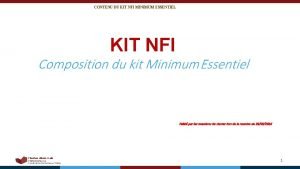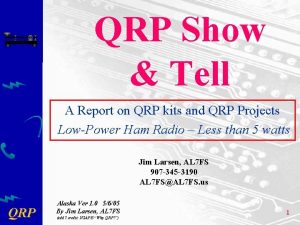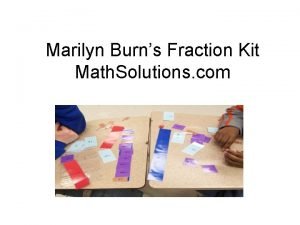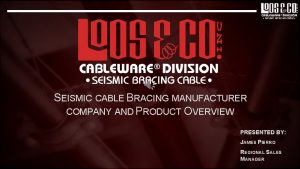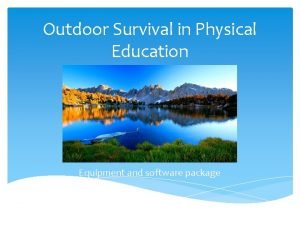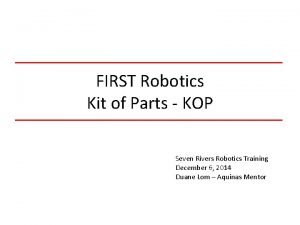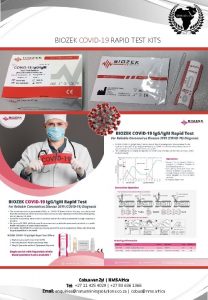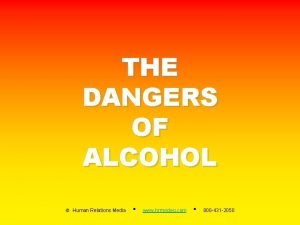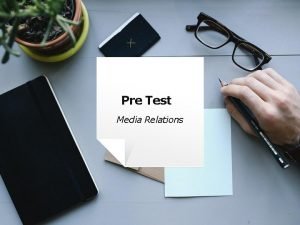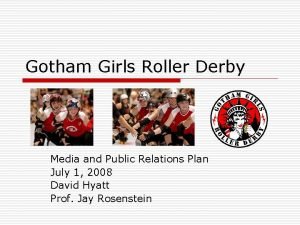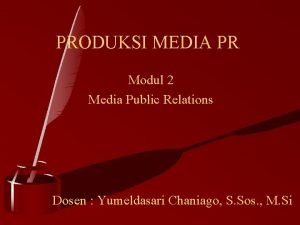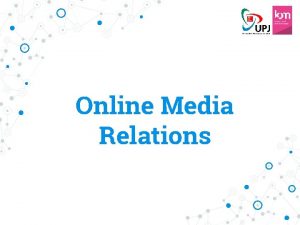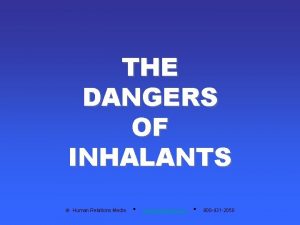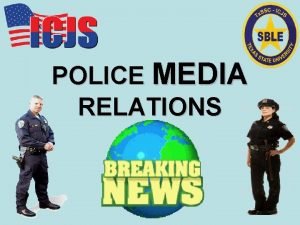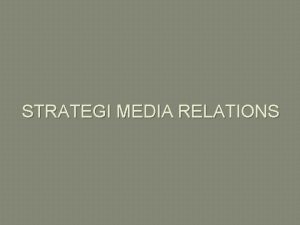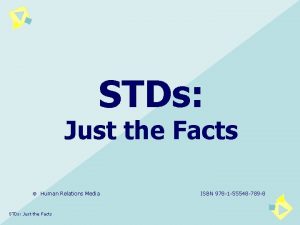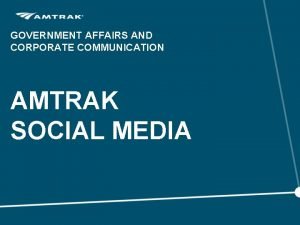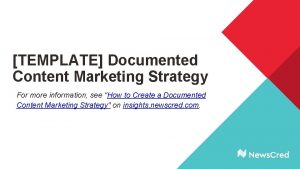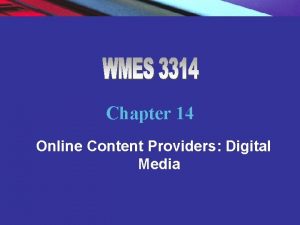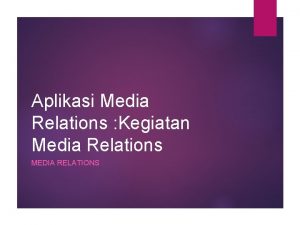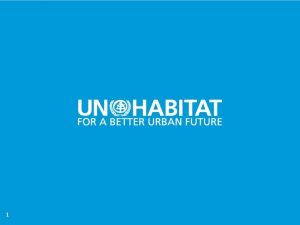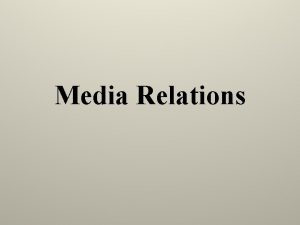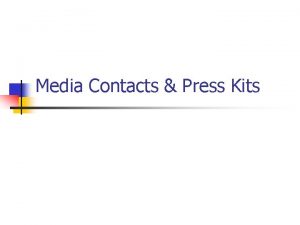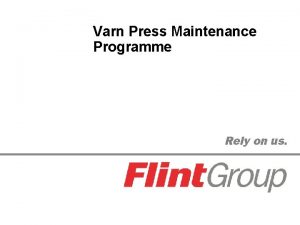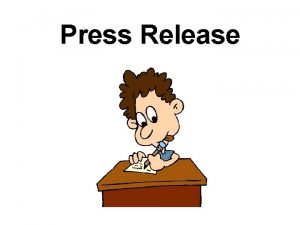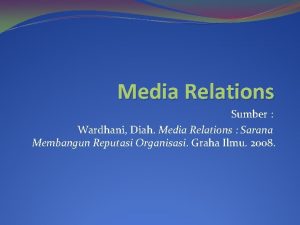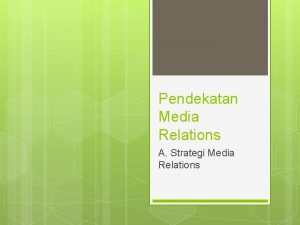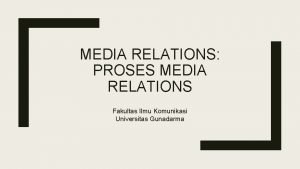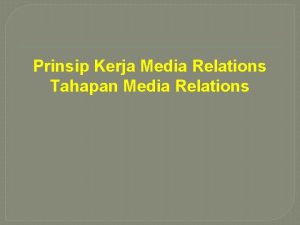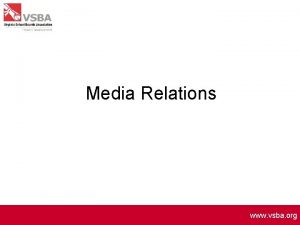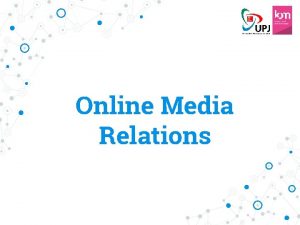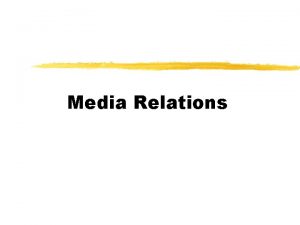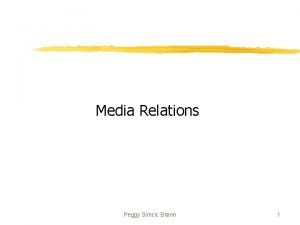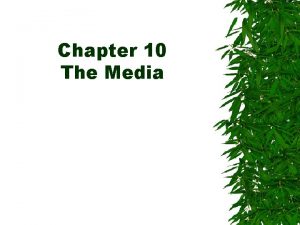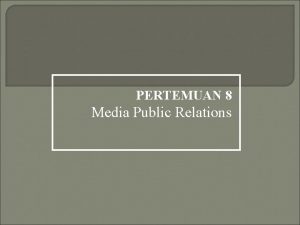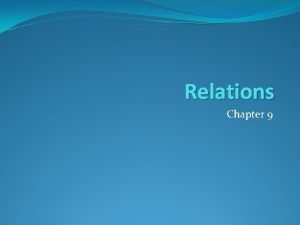Content What are the Media Relations Press Kits






























- Slides: 30


Content • What are the Media Relations? • Press Kits and Press Releases • How to Write a Press Release? • Audio, Video and Matte Releases • Website Press Room and Media Tour • Newsletters • Events/Functions Speaking Engagements • Employee interactions on a regular basis • Charity/Corporate social responsibility

What are the Media Relations? • Media relations involves working with media for the purpose of informing the public of an organization's mission, policies and practices in a positive, consistent and credible manner. • Media relations are the coordination with the people responsible for producing the news and features in the mass media. • The goal of media relations is to maximize positive coverage in the mass media without paying for it directly through advertising.

Press Kits and Press Releases • Press kits include written material about the organization and its top people. • A press release is a written statement to the media. It can announce a range of news items, including scheduled events, personal promotions, awards, new products and services, sales accomplishments, etc. It can also be used to generate a feature story. Reporters are more likely to consider a story idea if they first receive a press release. It is a fundamental tool of PR work, one that anyone who's willing to use the proper format can use.

How to Write a Press Release? • Write a genuine headline • How recognized as most reliable information source • Headlines written in bold! • First word capitalized • Extract important keywords

Write a genuine headline • It should be brief, clear and to the point: an ultra-compact version of the press release’s key point. • Plenty of PR professionals recommend writing your headline at the end, after the rest of the release is written. • If you follow that instruction, continue on and come back to writing the headline once the rest is done. • The headline is known as the eye-catcher and is very important to the whole release.

How recognized as most reliable information source • See how that works? Now you want to know more! News release headlines should have a "grabber" to attract journalists, just as a newspaper headline is meant to grab readers. • It may describe: - the latest achievement of an organization; - a recent newsworthy event; - a new product or service.

Headlines written in bold! • A bold headline also typically uses a larger font size than the body copy. • Conventional press release headlines use the present tense and exclude "a" and "the", as well as forms of the verb "to be" in certain contexts.

First word capitalized • As are all proper nouns. • Most headline words appear in lower-case letters, although using a stylized "small caps" font style can create a more graphically newsattractive look and feel. • Do not capitalize every word.

Extract important keywords • The simplest method to create the press release headline is to extract the most important keywords from your press release. • From these keywords, try to frame a logical and attention-getting statement. • If including a summary sentence after the headline, the same rules apply. • Using keywords early will give you better visibility in search engines, and it will be simpler for journalists and readers to get the idea of the press release content. • Look at the actions in this first step, and notice how every one of them could be a press release headline.

Write the body copy (1) • The press release should be written as you want it to appear in a news story. And remember this: most journalists are very busy, and don't have time to research your company's big announcement, so much of what you write for your press release will be what the journalists use in their writeup of your big event. Whatever you want them to say, this is where you put it. • Start with the date and city in which the press release originates. The city may be omitted if it will be confusing –– for example if the release is written in New York about events in the company's Chicago division.

Write the body copy (2) • The lead, or first sentence, should grab the reader and say concisely what is happening. For example, if the headline is "Careen Publishing releases new WWII novel, " the first sentence might be something like, "Carpren Publishing, Ltd. , today released their first World War II novel by celebrated writer Darcy Kay. " It expands the headline enough to fill in some of the details, and brings the reader further into the story. The next one to two sentences should then expand upon the lead. • The press release body copy should be compact. Avoid using very long sentences and paragraphs. Avoid repetition and overuse of fancy language and jargon. Strive for simplicity, and no wasted words.

Write the body copy (3) • The first paragraph (two to three sentences) should sum up the press release, and the additional content must elaborate it. In a fast-paced world, neither journalists, nor other readers, would read the entire press release if the start of the article didn't generate interest. • Deal with actual facts –– events, products, services, people, targets, goals, plans, projects. Try to provide maximum use of concrete facts. This is news. A simple method for writing an effective press release is to make a list of following clarifications: Who, what, when, where, why, and how.

Communicate the "5 W's" (and the H) clearly (1) • Who, what, when, where, why ––and how–– should tell the reader everything they need to know. Consider the checklist in context with the points below, using the example above to generate our press release: • Who is this about? Carpren Publishing. • What is the actual news? Carpren Publishing is releasing a book. • When does this even happen? Tomorrow. • Where does this even take place? In all major markets, tomorrow. • Why this is news? It was written by renowned author, Arcy Kay.

Communicate the "5 W's" (and the H) clearly (2) • How is this happening? The main event is at a book signing in Chicago, followed by a book tour to all the major metropolitan areas. • With the basics defined, fill in the gaps with information about the people, products, items, dates and other things related with the news. • If your company is not the main subject of the news, but is the source of the press release, make it clear in the body. • Keep it short and to the point. If you are sending a hard copy, the text should be double-spaced. • The more newsworthy you make the press release copy, the better the chances of it being selected by a journalist for reporting. Find out what "newsworthy" means to a given market and use this knowledge to hook the editor or reporter.

Make it clean, crisp, and applicable to your audience (1) • Odds are whoever you sent your press release to has a dozen just like it in his/her inbox just waiting to be ignored. If you want yours to be chosen, it's got to be good. Not only does it have to be good, but it has to be as close to "ready for press" as possible. • When an editor looks at your piece, he/she is thinking, from the first second, about how long it's going to take them to get it to print. If your work is full of errors, lacking content, or just needs to be revised, they're not going to waste their time. So make sure you have good grammar, all the basics, and have something to write about.

Make it clean, crisp, and applicable to your audience (2) • Why should these people care what you have to say? If you're sending it to the right audience, it'll be obvious. If you're not, well, why are you wasting your time? Give the right people a piece of news (news, not advertising) and you're on the right track. • They'll care more if you send it in the morning. That gives them time to pad your piece into what they're already working on. Be considerate.

Tie it together • Provide some extra information links that support your press release. Does the company you're selling have additional information online that readers may find useful? Great. Add it in. • If you're nervous about what you've got, do some research on what's already out there. Someone probably wrote something on an event just like the one you're covering. PR Web and PR Newswire are good places to start.

Audio, Video and Matte Releases • Audio releases or video releases are prerecorded messages distributed to various media channels. • Small local newspapers accept articles written by organizations when they do not have sufficient articles or stories to publish. Such releases are called as matte releases.

Website Press Room • Public relations experts promote their organization and its products/ services through online press rooms.

Media Tour • Public relations experts publicize their organization and its products through media tour where key people of the organization travel to important places and locations and promote their products through various interviews to media people. • They interact and share the benefits and USPs of their products/services with people from various news channels, radio channels and even print media. • Organizations also hire celebrities or other people popular among the masses to promote and publicize their organization.

Newsletters • Newsletters are nothing but publications which are distributed on a regular basis (monthly, quarterly) among target audiences. • Public relations experts collect complete information (name, address, age group) of their target customers and distribute newsletters to create awareness about their products. • Newsletters should include information about the organization, interview from key people, product information, testimonials from clients and so on.

Events/Functions Speaking Engagements • Public relations experts organize special events, gatherings, parties, to target their customers and promote their organization and its products among them. • People from media are also invited for coverage.

Employee interactions on a regular basis • One of indirect ways of publicizing an organization and its products is through interacting with potential customers and target audience. • Company officials address the target audience and do not only discuss about their products and services. • They generally prefer any topic which would interest the target audiences.

Charity/Corporate social responsibility • It is really essential for employers to stay in constant touch with employees and keep them abreast with the latest developments and happenings within the organization. • Management or public relations experts should circulatest events, new product launches among employees through emails, circulars, notices or simply communicating with them.

Possible reasons an organization may reach out to the media are: • • • Launch of a new product/service Initiation of new factories/offices Financial results Organization sponsored events or awards Launch of organization promotional campaigns Recent disasters, strikes or organizational closures Awards/accolades for the company Visits from company dignitaries/celebrities Involvement in local/community activities Community Engagement

Conclusions • Media relations involves working with media for the purpose of informing the public of an organization's mission, policies and practices in a positive, consistent and credible manner. • The main tools in media relations are: press kits, press releases, audio, video and matte releases, website press room, media tour, newsletters, ets. • The reasons for inviting journalists can be associated with corporate events, сharity, launch of a new product/service, initiation of new factories/offices, ets.

Recommended literature • Harrison K. Your media relations should have a strategic purpose. http: //www. cuttingedgepr. com/articles/mediarel_strategic_purpose. asp • NIKOLIC M. , TEREK E. , GLIGOROVIC B. / MEDIA RELATIONS AS A PRIMARY ACTIVITY OF PUBLIC RELATIONS. // УПРАВЛЕНИЕ ИЗМЕНЕНИЯМИ В СОЦИАЛЬНО-ЭКОНОМИЧЕСКИХ СИСТЕМАХ. Воронеж, 2015, P. 6 -16. http: //elibrary. ru/item. asp? id=24257197 • Salzman M. Media Relations: Still Important. http: //www. forbes. com/sites/mariansalzman/2016/06/03/media-relations-still-important/#6 a 204 c 9 a 11 cc • SUZIĆ B. , KARLÍČEK M. , STŘÍTESKÝ V. ADOPTION OF SOCIAL MEDIA FOR PUBLIC RELATIONS BY MUSEUMS. // CENTRAL EUROPEAN BUSINESS REVIEW, Central European Business Review (Прага), 2016, № 2, Т. 5, P. 5 -16 http: //elibrary. ru/item. asp? id=26404363 • TAMBOVTSEV A. I. INTERACTION OF INTERNAL AFFAIRS BODIES WITH THE MEDIA: ADVANTAGES AND SHORTCOMINGS OF THE CURRENT NORMATIVE LEGAL ACTS // THE TOPICAL ISSUES OF PUBLIC LAW. 2014, № 1, P. 90 -104 http: //elibrary. ru/item. asp? id=21377667

Training and methodological support for selfstudy 1. Read the recommended articles. What processes in modern media relations are dealt with in these articles? 2. Look on the websites of foreign companies press releases in English. 3. Analyze their structure and contents, in terms of the rules of writing a press release. 4. Write a press release for the company where you interned.

Thank you for your attention! Any questions? Contacts: prconsult@list. ru
 Antigentest åre
Antigentest åre Employee relations in public relations
Employee relations in public relations Image
Image Nfi kits
Nfi kits Kits vs hirv
Kits vs hirv Index labs qrp plus
Index labs qrp plus Kit oreillette arbitre handball
Kit oreillette arbitre handball Cell membrane bubble lab answers
Cell membrane bubble lab answers Whp homeopathy
Whp homeopathy Aircraft cable seismic manufacturer
Aircraft cable seismic manufacturer Outdoor software
Outdoor software First robotics kit of parts
First robotics kit of parts Biozek testing kits
Biozek testing kits Kits courseweb
Kits courseweb Kit 1 std
Kit 1 std Characteristics of esp
Characteristics of esp Static content vs dynamic content
Static content vs dynamic content Human relations media
Human relations media Hubungan pr dengan media
Hubungan pr dengan media Media relations derby
Media relations derby Produksi media public relations
Produksi media public relations Online media relations
Online media relations Paige wolf media & public relations
Paige wolf media & public relations Human relations media
Human relations media Houston police media relations
Houston police media relations Strategi media relations
Strategi media relations Sti vs std
Sti vs std Amtrak media relations
Amtrak media relations Content pillars for instagram
Content pillars for instagram Digital media content providers
Digital media content providers Hát kết hợp bộ gõ cơ thể
Hát kết hợp bộ gõ cơ thể



